Ah gits weary
An’ sick of tryin’
Ah’m tired of livin’
An’ skeered of dyin’,
But ol’ man river,
He jes’ keeps rollin’ along!
—— lyrics by Oscar Hammerstein II
A study of the similarities and differences among the stage play, the musical and the three films which sprang from Edna Ferber’s novel Show Boat is both interesting and disheartening—interesting for the number of technical improvements made over the years, especially regarding the films, and disheartening for the critical messages that, at times, receive varying degrees of emphasis.
Aside from the evils of racial discrimination—the novel takes place in 1887—a key element in the plot is miscegenation, a mid-nineteenth-century term created to denote intermarriage between different races, which involves two of the main characters. The mention of miscegenation had been banned from the 1929 film version, and even fifteen years later M-G-M had to tread cautiously with the subject, though it finally received approval from the dreaded watchdogs at the Hays Office.
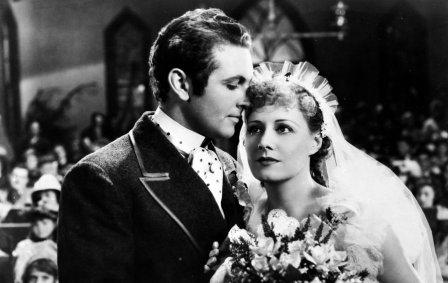 Among the three movie versions of the operetta, the most crucial comparison must be that between the second and third; the 1929 version, a part-talkie, has only a few songs and some scenes are lost. There are those who prefer Irene Dunne and Allan Jones in 1936, plus the magnificent singing voices of torch singer Helen Morgan and Paul Robeson as Joe, the downtrodden back man, and the source of the operetta’s signature tune, “Ol’ Man River.” Some feel this is the best, over-all, of the three movies, thanks in one respect to director James Whale, who considered it the favorite of his films.
Among the three movie versions of the operetta, the most crucial comparison must be that between the second and third; the 1929 version, a part-talkie, has only a few songs and some scenes are lost. There are those who prefer Irene Dunne and Allan Jones in 1936, plus the magnificent singing voices of torch singer Helen Morgan and Paul Robeson as Joe, the downtrodden back man, and the source of the operetta’s signature tune, “Ol’ Man River.” Some feel this is the best, over-all, of the three movies, thanks in one respect to director James Whale, who considered it the favorite of his films.
Against this, there are others who prefer the later account with Kathryn Grayson and Howard Keel. From the master studio of musicals, especially during the zenith of the genre in the 1950s, M-G-M delivers a more sophisticated and polished production than Whale’s small Universal Pictures. Robeson’s own vocal prowess now has its strongest competitor in the resonant bass-baritone of William Warfield, who has his own champions as the Joe. Here, too, is Technicolor, which if it favors no one or anything else, it favors the beautiful Ava Gardner, one half of the miscegenation marriage.
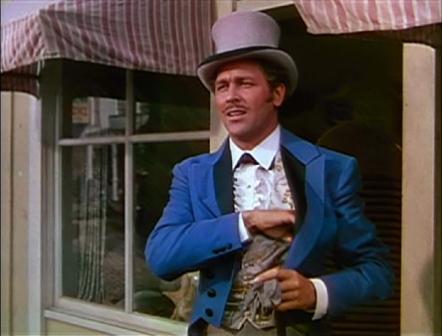 Edna Ferber’s novel is typical of the book-to-play-to-musical-to-movie metamorphosis these artistic creations often undergo. Ferber, who also wrote Cimarron (1929) and Giant (1952), worked on Show Boat in the Basque village of St. Jean de Luz, in Paris and, finally, in New York. From April to September, 1926, it was serialized in Woman’s Home Companion before being published in book form in August of that year.
Edna Ferber’s novel is typical of the book-to-play-to-musical-to-movie metamorphosis these artistic creations often undergo. Ferber, who also wrote Cimarron (1929) and Giant (1952), worked on Show Boat in the Basque village of St. Jean de Luz, in Paris and, finally, in New York. From April to September, 1926, it was serialized in Woman’s Home Companion before being published in book form in August of that year.
Ferber was initially shocked that her story was to be made into a musical. Operettas at the time had little or no plots, light, romantic tunes strung together with scant unity, comedy sketches, shallow character development, if any, and, sometimes, scantily clad young ladies. Although the Show Boat story dealt with serious subjects, not only miscegenation but alcoholism and two wife desertions, lyricist Oscar Hammerstein II saw in it a radical change for a musical, and wrote a libretto.
Florenz Ziegfeld was the king of Broadway at the time, known for such revues as his “Ziegfeld Follies,” famous for the beautifully costumed girls. He liked what Hammerstein had done, and now with the added music of composer Jerome Kern, he decided to stage it. The composer and lyricist had previously collaborated on several musicals. After tryouts in Washington and other cities, Show Boat made its Broadway début December 27, 1927.
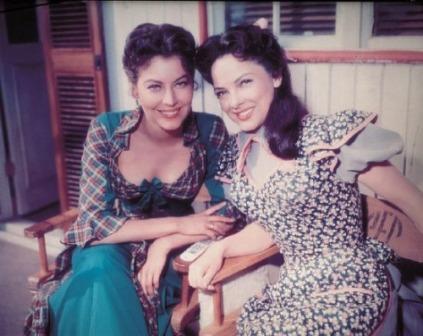 It was an instant hit and marked a turning point for the serious musical. The spirit of Show Boat, with its dramatic plot, integrated songs and distinctive characters, inspired similar musicals—George and Ira Gershwin’s Porgy and Bess (1935, the lives of poor African-Americans in Catfish Row), Kurt Weill and Ira Gershwin’sLady in the Dark (1941, psychoanalysis), Richard Rogers and Hammerstein’s Oklahoma! (1943, the complete integration of story and music) and the latter artists’ South Pacific (1949, once again with a subject of racial intermarriage).
It was an instant hit and marked a turning point for the serious musical. The spirit of Show Boat, with its dramatic plot, integrated songs and distinctive characters, inspired similar musicals—George and Ira Gershwin’s Porgy and Bess (1935, the lives of poor African-Americans in Catfish Row), Kurt Weill and Ira Gershwin’sLady in the Dark (1941, psychoanalysis), Richard Rogers and Hammerstein’s Oklahoma! (1943, the complete integration of story and music) and the latter artists’ South Pacific (1949, once again with a subject of racial intermarriage).
The Cotton Blossom, a paddle-wheel Mississippi riverboat, has docked at a river town in the Deep South. Operated by Captain Andy Hawks (Joe E. Brown), he and his wife Parthy (Agnes Moorehead) run a vaudeville show which features as star attractions Julie LaVerne (Gardner) and her husband Steve (Robert Sterling).
Beginning during the opening credits, the troupe introduces themselves with a chorus of “Cotton Blossom” and extols all the wonderful entertainment now coming to the town. But a fistfight erupts between Steve and the boat’s engineer, Pete (Leif Erickson), who has been making advances toward Julie. Captain Andy announces the ruckus as part of the show, and Pete runs off, saying he’ll get even.
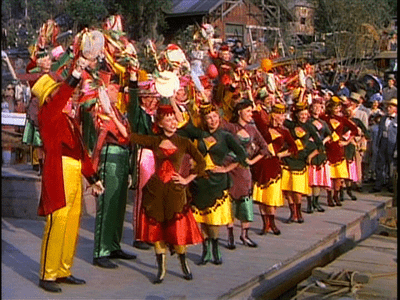 Soon after, Gaylord Ravenal (Keel), a riverboat gambler down on his luck, pretends to be an actor to acquire passage on the boat, but Captain Andy explains an actor isn’t needed. Ravenal sings “Where’s the Mate for Me?” and, in the process, is captivated by Captain Andy’s young daughter Magnolia (Grayson), and she by him. This necessitates another of Show Boat’s endearing songs, “Make Believe,” a duet between the two.
Soon after, Gaylord Ravenal (Keel), a riverboat gambler down on his luck, pretends to be an actor to acquire passage on the boat, but Captain Andy explains an actor isn’t needed. Ravenal sings “Where’s the Mate for Me?” and, in the process, is captivated by Captain Andy’s young daughter Magnolia (Grayson), and she by him. This necessitates another of Show Boat’s endearing songs, “Make Believe,” a duet between the two.
On an upper deck of the riverboat, in a beautiful green dress, Julie sings “Can’t Help Lovin’ Dat Man” (Gardner’s voice dubbed by Annette Warren) and shares a little dance with Magnolia, her best friend. Gardner is lusciously photographed by Charles Rosher (nominated for color cinematography)—some critics have said too lusciously, with too many close-ups and some awkward choreography.
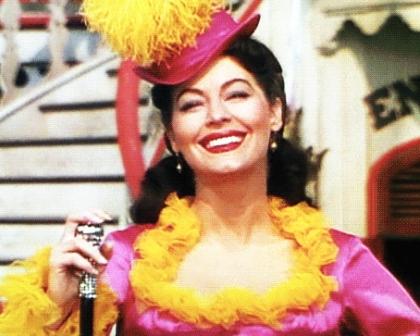 In one of the liveliest of the show’s numbers, starting out on a revolving two-seater chair, two members of the company (Madge and Gower Champion, husband and wife in real life), sing “I Might Fall Back on You.” He brags, “Some girls say I’m not so bad!” She counters, “Others say you’re not so good!” The chair is pulled off stage (clearly seen) and they end the duet in a high-stepping dance.
In one of the liveliest of the show’s numbers, starting out on a revolving two-seater chair, two members of the company (Madge and Gower Champion, husband and wife in real life), sing “I Might Fall Back on You.” He brags, “Some girls say I’m not so bad!” She counters, “Others say you’re not so good!” The chair is pulled off stage (clearly seen) and they end the duet in a high-stepping dance.
By now, Pete has returned with the sheriff (Regis Toomey), who announces there is a case of miscegenation on the boat. Julie admits that she is half African-American and Steve says that so is he, only because earlier he had pricked Julie’s finger with a straight pin and sucked her blood. Both are exiled from the Cotton Blossom, and leave together in a buckboard.
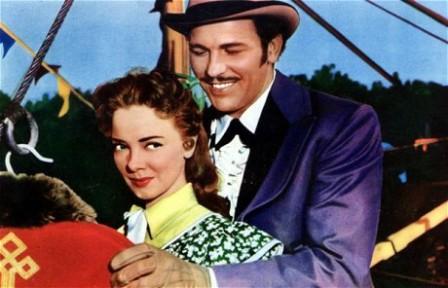 At this point, as the riverboat paddles away from the dock, and Julie and Steve look back forlornly, Joe sings his one and only song—need he sing another? “Ol’ Man River” rolls out of him like soft thunder as he laments the misery of his life—“Tote dat barge!/Lif’ dat bale!”—while the indifferent Mississippi passes alongside.
At this point, as the riverboat paddles away from the dock, and Julie and Steve look back forlornly, Joe sings his one and only song—need he sing another? “Ol’ Man River” rolls out of him like soft thunder as he laments the misery of his life—“Tote dat barge!/Lif’ dat bale!”—while the indifferent Mississippi passes alongside.
Without his two leading stars, Captain Andy now hires Ravenal, and as the Cotton Blossom journeys down the river, from town to town, he and Magnolia become sensations. Not only that, they fall in love, much to the annoyance of Parthy, and marry. Having lived on Ravenal’s gambling wins, when he begins to lose, Magnolia rebukes him for his gaming habit (a plot departure from the stage and 1936 film version). Feeling guilty, he leaves.
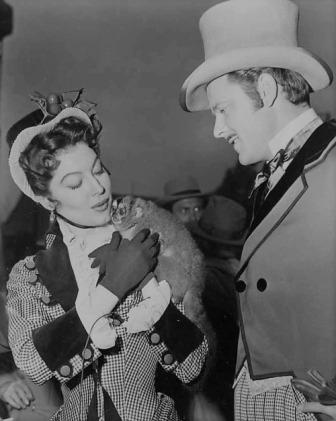
In his wanderings, Ravenal comes across the exiled Julie, now a singer on another riverboat, but Steve has left her and she has become an alcoholic. Julie discovers Ravenal’s identity and heatedly condemns him for leaving Magnolia when she was pregnant. Knowing nothing of the pregnancy, he feels another kind of guilt and returns to the Cotton Blossom. There on the dock he happens upon his four-year-old daughter Kim (Sheila Clark) and sings to her a whispery version of “Make Believe.”
Magnolia and Ravenal are reconciled and walk the dock back to the riverboat. As Joe sings a reprise of “Ol’ Man River,” Julie, on the dock, blows a kiss to Magnolia. The boat pulls away, the great rear paddle-wheel churning the waters of the Mississippi, the screen framed by the trees and foliage of the riverbank.
It’s become a cliché, a thought attributed to just about everybody: the American Musical Theatre is easily divided into two eras, everything before Show Boat, and everything after Show Boat.
